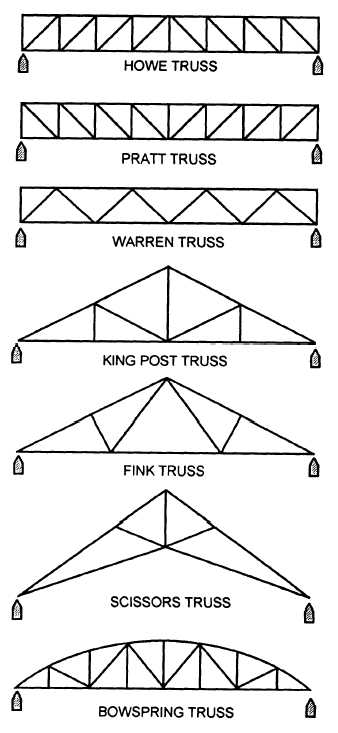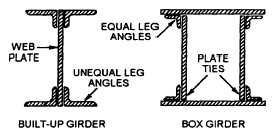Figure 1-39.—Typical built-up girders.
which are, in turn, supported by columns. The horizontal
members or beams that connect the exterior columns are
called spandrel beams. If you add additional rows of
columns and beams, there is no limitation to the area of
floor and roof that can be supported using skeleton
construction. One limitation on using skeleton
construction, however, is the distance between columns.
Oftentimes, large structures, such as aircraft
hangars, may require greater distances between
supports than can be spanned by the standard structural
steel shapes. In this case, one of several methods of
long-span steel construction is used. One method uses
built-up girders to span the distances between supports.
Two types of built-up girders are shown in figure 1-39.
As seen in this figure, the built-up girder consists of steel
plates and shapes that are combined together to meet the
necessary strength. The individual parts of these girders
are connected by welding or riveting.
Another method, which is usually more
economical, is to use a truss to span large distances. As
you learned in the EA3 TRAMAN, a truss is a frame-
work of structural members consisting of a top chord,
bottom chord, and diagonal web members that are
usually placed in a triangular arrangement. (See figs.
1-40 and 1-41.) As shown in figure 1-40, trusses can be
fabricated to conform to the shape of nearly any roof
system.
A third long-span method, although not as versatile
as trusses, is the use of bar joists. Bar joists are much
lighter than trusses and are fabricated in several different
types. One type is shown in figure 1-42. Prefabricated
bar joists, designed to conform to specific load
requirements, are obtainable from commercial
companies. Other long-span construction methods
involve several different types of framing systems,
which include steel arches, cable-hung frames, and
other types of systems. These methods are beyond the
scope of this TRAMAN.
Figure 1-40.—Typical steel trusses.
1-20



